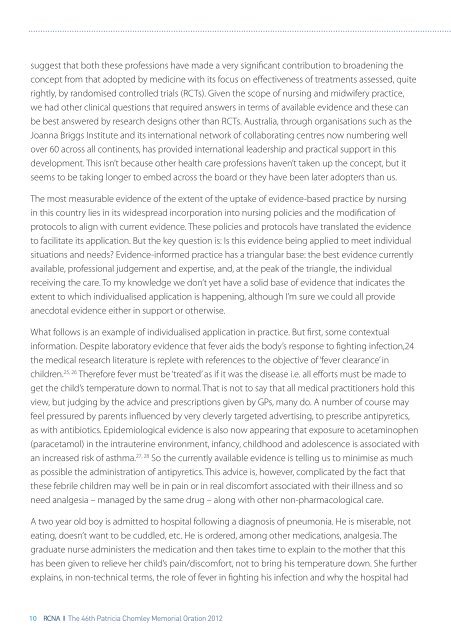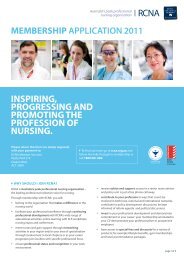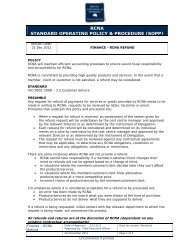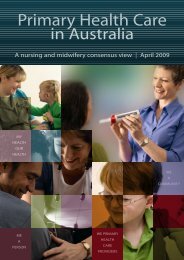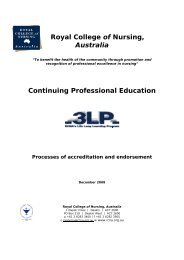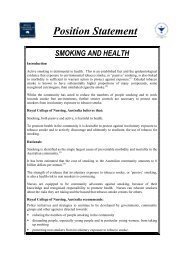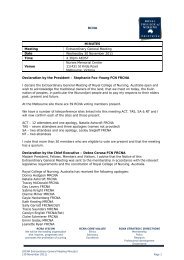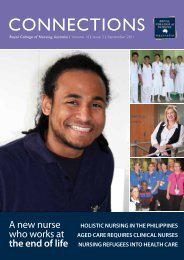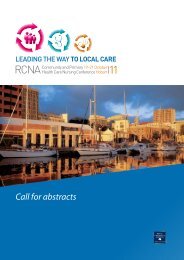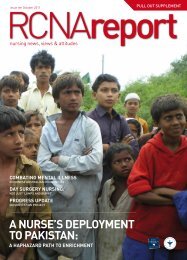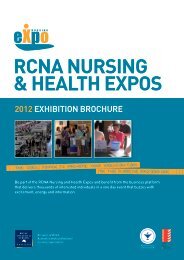the 46th patricia chomley memorial oration 2012 - Royal College of ...
the 46th patricia chomley memorial oration 2012 - Royal College of ...
the 46th patricia chomley memorial oration 2012 - Royal College of ...
You also want an ePaper? Increase the reach of your titles
YUMPU automatically turns print PDFs into web optimized ePapers that Google loves.
suggest that both <strong>the</strong>se pr<strong>of</strong>essions have made a very significant contribution to broadening <strong>the</strong>concept from that adopted by medicine with its focus on effectiveness <strong>of</strong> treatments assessed, quiterightly, by randomised controlled trials (RCTs). Given <strong>the</strong> scope <strong>of</strong> nursing and midwifery practice,we had o<strong>the</strong>r clinical questions that required answers in terms <strong>of</strong> available evidence and <strong>the</strong>se canbe best answered by research designs o<strong>the</strong>r than RCTs. Australia, through organisations such as <strong>the</strong>Joanna Briggs Institute and its international network <strong>of</strong> collaborating centres now numbering wellover 60 across all continents, has provided international leadership and practical support in thisdevelopment. This isn’t because o<strong>the</strong>r health care pr<strong>of</strong>essions haven’t taken up <strong>the</strong> concept, but itseems to be taking longer to embed across <strong>the</strong> board or <strong>the</strong>y have been later adopters than us.The most measurable evidence <strong>of</strong> <strong>the</strong> extent <strong>of</strong> <strong>the</strong> uptake <strong>of</strong> evidence-based practice by nursingin this country lies in its widespread incorp<strong>oration</strong> into nursing policies and <strong>the</strong> modification <strong>of</strong>protocols to align with current evidence. These policies and protocols have translated <strong>the</strong> evidenceto facilitate its application. But <strong>the</strong> key question is: Is this evidence being applied to meet individualsituations and needs? Evidence-informed practice has a triangular base: <strong>the</strong> best evidence currentlyavailable, pr<strong>of</strong>essional judgement and expertise, and, at <strong>the</strong> peak <strong>of</strong> <strong>the</strong> triangle, <strong>the</strong> individualreceiving <strong>the</strong> care. To my knowledge we don’t yet have a solid base <strong>of</strong> evidence that indicates <strong>the</strong>extent to which individualised application is happening, although I’m sure we could all provideanecdotal evidence ei<strong>the</strong>r in support or o<strong>the</strong>rwise.What follows is an example <strong>of</strong> individualised application in practice. But first, some contextualinformation. Despite laboratory evidence that fever aids <strong>the</strong> body’s response to fighting infection,24<strong>the</strong> medical research literature is replete with references to <strong>the</strong> objective <strong>of</strong> ‘fever clearance’ inchildren. 25, 26 Therefore fever must be ‘treated’ as if it was <strong>the</strong> disease i.e. all efforts must be made toget <strong>the</strong> child’s temperature down to normal. That is not to say that all medical practitioners hold thisview, but judging by <strong>the</strong> advice and prescriptions given by GPs, many do. A number <strong>of</strong> course mayfeel pressured by parents influenced by very cleverly targeted advertising, to prescribe antipyretics,as with antibiotics. Epidemiological evidence is also now appearing that exposure to acetaminophen(paracetamol) in <strong>the</strong> intrauterine environment, infancy, childhood and adolescence is associated withan increased risk <strong>of</strong> asthma. 27, 28 So <strong>the</strong> currently available evidence is telling us to minimise as muchas possible <strong>the</strong> administration <strong>of</strong> antipyretics. This advice is, however, complicated by <strong>the</strong> fact that<strong>the</strong>se febrile children may well be in pain or in real discomfort associated with <strong>the</strong>ir illness and soneed analgesia – managed by <strong>the</strong> same drug – along with o<strong>the</strong>r non-pharmacological care.A two year old boy is admitted to hospital following a diagnosis <strong>of</strong> pneumonia. He is miserable, noteating, doesn’t want to be cuddled, etc. He is ordered, among o<strong>the</strong>r medications, analgesia. Thegraduate nurse administers <strong>the</strong> medication and <strong>the</strong>n takes time to explain to <strong>the</strong> mo<strong>the</strong>r that thishas been given to relieve her child’s pain/discomfort, not to bring his temperature down. She fur<strong>the</strong>rexplains, in non-technical terms, <strong>the</strong> role <strong>of</strong> fever in fighting his infection and why <strong>the</strong> hospital had10 RCNA The <strong>46th</strong> Patricia Chomley Memorial Oration <strong>2012</strong>


